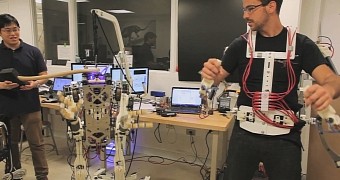Yes, we are indeed one step closer to Gundam. Although in smaller size for now, the basics are here and are truly impressive. Created in the context of a recent DARPA challenge, the puppet-robot will follow its master’s every move.
Independent robots with self-moving logics, locomotion autonomy and self-sustaining skills are still a big challenge for today’s researchers. Until now, such machines have never passed the level of toddler-like movements and could hardly be considered fit for any work environment. However, when being controlled puppet-style by a human, things change radically.
In the recent DARPA challenge, MIT researchers managed to build a robot that acts like a puppet that relies on its operator for speed, balance and dexterity. Similar to drones and remote-driven cars, the robots will react only to the inputs given by a “driver” and will be able to operate in locations impossible for humans to survive, like underwater or highly radiated areas, or even other planets. Acting like proxies for humans, robots will be able to add extra humanoid agility both in force and speed under the command of a human at a considerable distance.
Much better as proxies than fully autonomous
However, different from current remotely controlled devices, the new MIT robots have an extra feature - they are able to send back to their operator the force-feedback they are experiencing in order to counteract it and help the machine stay balanced. To do this, the operator wears a complex suit that sends to the robot every bit of information it needs to keep its balance, giving it also incredible accuracy and dexterity.
For example, if the robot loses its balance after stepping on some uneven terrain, the operator will feel this and will lean on the opposite side, helping the robot gain its balance again. The main advantage of this machine is that it can do everything a man needs to do in high-risk environments without any extra research in robotics and software to do this autonomously, while obviously being much cheaper than any autonomous robots today.
One thing it needs though: to be clad in armor and be four times the size of a man. You could send it to space to fight aliens and do some space exploration. So yeah, you know what I mean.
However, the Japanese may be much closer to Gundam than we think.

 14 DAY TRIAL //
14 DAY TRIAL // 